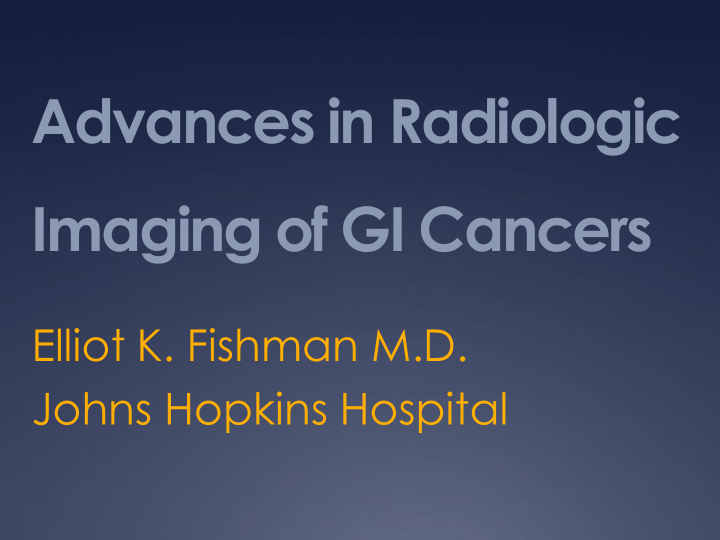



Advances in Radiologic Imaging of GI Cancers Elliot K. Fishman M.D. Johns Hopkins Hospital
Radiologic Oncologic Imaging 2009 MDCT MRI PET/CT Ultrasound
MDCT vs MRI: Some Questions What is the clinical problem? What information should the study provide? What is the patients renal status? What technology is available? What is the expertiece of the interpreting radiologist?
CTA vs MRA Scanner resolution Patient comfort Anatomic detail 3D mapping
Evolution of MDCT 1989 single slice spiral CT 1992 dual slice spiral CT 1999 four slice spiral CT 2001 eight slice spiral CT 2002 sixteen slice spiral CT 2004 sixty four slice spiral CT 2005 dual source CT 2007 128, 256 and 320 MDCT 2008 GE HRCT and Siemens Flash
The CT Scan Journey Thru Time year Scan Slice Interscan Total # of speed thickness spacing slices 1980 10 sec 10mm 10mm 25-30 1985 5 sec 8-10 mm 8-10 mm 30-45 1990 1 sec 3-5 mm 3-5 mm 100 1995 .75 sec 3 mm 2-3 mm 100 1999 .5 sec 1-3 mm 1-3 mm 220 2003 .4 sec .5-.75mm .5-.75 mm 400-1200 2005 .33 sec .5-.6 mm .5-.75 mm 600-4000
What are the key advantages of 64 slice MDCT? Spatial resolution Temporal resolution Isotrophic datasets
What are the key advantages of 64 slice MDCT? Spatial resolution ( < .4 mm) Temporal resolution Isotrophic datasets
What are the key advantages of 64 slice MDCT? Spatial resolution Temporal resolution (160- 180 msec, 83 msec for DS) Isotrophic datasets
Scanning Capabilities 2009: Hardware and Software Dual energy CT Perfusion CT CAD (computer assisted detection) Tumor volumetrics (automated calculation of tumor response to therapy)
FNH-Classic Enhancement Pattern
Neuroendocrine Tumor Metastatic to Liver
Small Pancreatic Cancer
1 cm Islet Cell Tumor
Hepatoma with Neovascularity
VRT MIP
Carcinoid Tumor in Root of Mesentery
Gastric GIST
conclusion New technology critical in GI Oncologic Imaging 3D mapping critical in lesion detection, characterization and management decision making
Recommend
More recommend